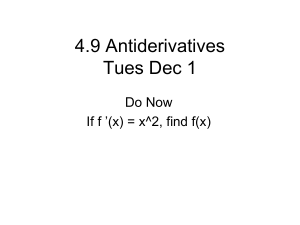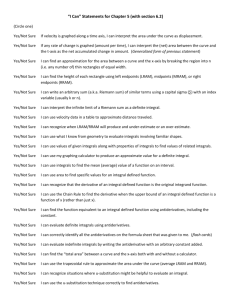AP Calculus Unit 5 Day 6
advertisement
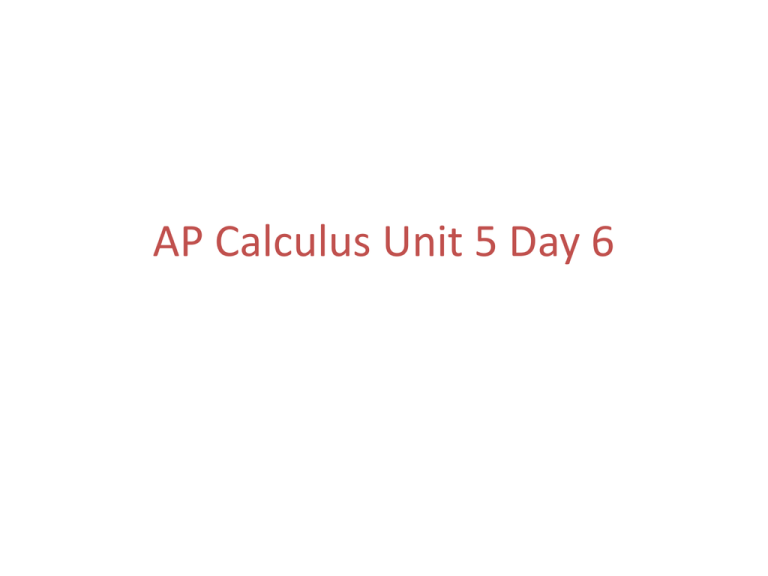
AP Calculus Unit 5 Day 6 x Given g ( x) 3t dt , evaluate g(2). 2 2 2 g (2) 3t 2 dt 0 2 When upper bound =lower bound, b f (t ) dt 0 a Explain why this makes sense based on your knowledge of what an integral represents. x Given g ( x) f (t ) dt 3 5 f (t ) dt 7 3 1. 2. 3. 4. 8 10 3 8 f (t ) dt 12 g (3) g (5) g (10) g (8) g (5) f (t ) dt 2 x g ( x) f (t ) dt Given 3 5 f (t ) dt 7 8 10 3 8 f (t ) dt 12 3 f (t ) dt 2 3 1. g (3) f (t ) dt 0 3 5 2. g (5) f (t ) dt 7 3 10 3. g (10) f (t ) dt 12 2 14 3 8 5 3 3 4. g (8) g (5) f (t ) dt f (t ) dt 12 7 5 What have we learned so far about integration? •Finding the area between a curve and the x-axis. •Estimating integrals using Riemann Sums •Finding exact values of integrals using the calculator-- “fnInt” What have we not learned, YET ? How to find exact integral values without using “fnInt” when the region bounded by the function and the x-axis is not some shape that we can apply geometry area formulas to. Fundamental Theorem of Calculus (FTC) Mathematicians had known about derivatives and how to use them for hundreds of years. It was also known that integrals and areas were the keys to solving many problems, but no one knew how to solve them. The significance of the FTC is Until …..FTC that it unites Differential and Integral Calculus and, in the process, tells us how to evaluate integrals. Today’s Learning Outcomes Define and find antiderivatives Make connections between derivatives, antiderivatives and integrals State and apply FTC in order to evaluate definite integrals Evaluate definite integrals without using fnInt or Geometry Terminology: A function F(x) is an antiderivative of a function f(x) if F’(x)=f(x). Examples: f ( x) x 3 9 x 2 g ( x) sin x x4 F ( x) 3x 3 C 4 “C” is a constant F’(x)=f(x) G ( x) cos x C h( x) csc2 x H ( x) cot x C G’(x)=g(x) H’(x)=h(x) By convention, we CAPITALIZE to denote the antiderivative. Using mathematical symbols . . . Finding the antiderivative of a function is also called integration F ( x) C f ( x) dx NOTE: There are no boundaries on this integration. This is referred to as an indefinite integral. MORE later. Fundamental Theorem of Calculus, (Evaluation Part) If f is continuous at every point of a, b , and if F is any antiderivative of f on a, b , then b a f ( x)dx F (b) F (a) MUST meet these conditions!!!!! Again, for emphasis Antiderivatives can be used to evaluate integrals. b f ( x)dx F (b) F (a) a Where F is an antiderivative of f. BEAUTIFUL! Now we have the power to evaluate statements like 2 3 2 ( x 9 x )dx without using fnInt or Geometry… 0 Lets Try: 1 Determine the antiderivative,F(x), of the integrand, f(x). 2 Next find F(b) and F(a). 3 Finally, find F(b)-F(a) Formatting our work: x 2 0 3 9x 2 1 4 3 2 3(2 ) 4 2 1 4 3 dx x 3x 4 0 = -20 1 4 3 0 3(0 ) 4 Practice 4 7 1 5 3 x dx 4 2x dx Other Examples …… Remember your Algebra Skills 8 x 1 2 8 x 2 x 1 dx dx 2 3 3 x 2x x 2x dx dx x 2 dx 3 x x x 3 3 8 2 8 2 8 Integrate using the power rule 2 1 dx 1 x3 Integrate using the power rule???? 2 1 dx 1 x What function, F ( x) 2 REGROUP: ,has a derivative of 1 dx ln 1 x 1 f ( x) ? x x 1 2 ln(2) ln(1) ln 2 AN EXPLORATION . . . Draw the graph of Is f ( x) 1 x 1 f ( x) x an odd or even function? 2 1 Given that dx ln 2 and based on the symmetry of the x 1 1 function what would you predict the value of Let’s try to confirm by using the FTC: 1 1 1 2 x dx ln x 2 ln(1) ln(2) 1 2 x dx to be? 1 2 1 1 dx ln x 2 ln(1) ln(2) x A simple solution would be: 1 2 1 dx ln x x 1 2 ln 1 ln 2 ln 2 Which is in fact what we predicted: 1 2 2 1 1 dx ln 2 dx x x 1 Summary . . . . Due to the symmetry of 1 f ( x) x , a b b1 1 dx dx . a x x Since the domain of F ( x) ln x , which is the antiderivative of 1 f ( x) x is (0, ) it is not possible to evaluate d c 1 dx x for values of c 0 or d 0 using the FTC unless we write the antiderivative as F ( x) ln x . Conclusion b 1 dx ln x a x b a Others …… 1 k xdx k ln x C e dx e C x x x a a dx ln a C x You Try! 5 5 5 1 1 1 1 2 x dx 2 ln x 2 ln x 1 1 2 4 dx x 0 6 x 4 ln 4 0 2 e 2 e dx x 4 2 x 6 4 Thumbs up? Today’s Learning Outcomes Define and find antiderivatives Make connections between derivatives, antiderivatives and integrals State and apply FTC in order to evaluate definite integrals Evaluate definite integrals without using fnInt or Geometry MORE Learning Outcomes Find antiderivatives of trig functions Find antiderivatives of absolute value functions Finding Trig antiderivatives b b sin x dx cos x dx b b a a 2 sec x dx 2 csc x dx b b a csc x cot x dx a Ex: 5 4 z 2 sin x dx a sec x tan x dx a You Try: cos x dx 2 4 sec x dx 2 0 “What about Absolute Value Problems?” ò 4 1 2x - 4 dx Discuss with your partner what might need to be done!!! Remember an absolute value function is really a piecewise function. 2 x 4 , x 2 2x 4 x2 2 x 4, 4 SO….. 2 x 4 dx 1 2 4 (2 x 4) dx (2 x 4) dx 1 2
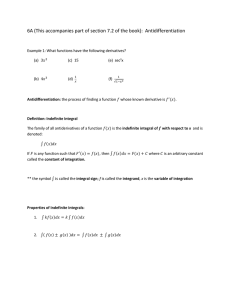
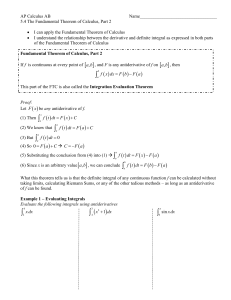
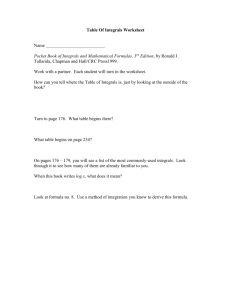
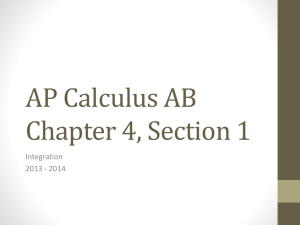
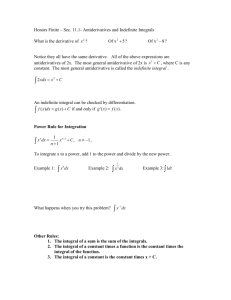
![Antiderivatives [7.5]](http://s2.studylib.net/store/data/009839726_1-71c8c3c8e7789734542b65fee1d9e6d4-300x300.png)
